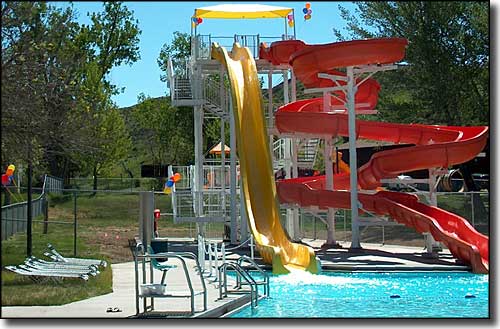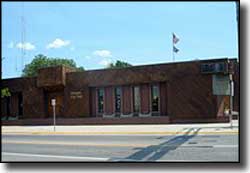
Douglas, Wyoming

At the Douglas Water Park

Douglas was officially founded by the Fremont, Elkhorn & Missouri Valley Railroad when they built a train depot there in 1886. They named the settlement after Stephen A. Douglas, a politician and statesman from Illinois. However, since Fort Fetterman was built in 1867, a settlement known as "Tent City" (or "Fetterman City") had been near the same location. At the time Fort Fetterman was built, negotiations that resulted in the abandonment of military forts further north were going on in the aftermath of Red Cloud's War. Fort Fetterman was built on the southern banks of the North Platte River, just outside the boundaries set by the 2nd Fort Laramie Treaty (1868). With the building of Fort Fetterman, Fort Casper to the south was abandoned and the troops moved to Fort Fetterman.
Winters were long and hard here and desertions were frequent. Fort Fetterman figured prominently in the Black Hills War in the mid-1870's. Fort Fetterman was decommissioned in 1882 as the Indian Wars had pretty much ended. With the establishment of Douglas, Tent City was abandoned. The site of Fort Fetterman is managed today as a historic site by the Wyoming State Historical Society and is listed on the National Register of Historic Places.
Douglas lies along the Oregon and Bozeman Trails (at the modern-day intersection of the I-25 and Highway 59). The early days of the area saw a lot of cattleman-homesteader conflicts and political struggles. Then came the fateful winter of 1886-1887 and huge numbers of cattle froze to death all over eastern Wyoming. At that point, a lot of cattle ranchers became sheep ranchers. The mountain pastures and vast prairie grasslands lent themselves well to this. Douglas grew as a shipping point for cattle and sheep until the railway work shifted more to the west. Douglas dwindled a bit but business remained fairly static for the next 70 years. Then uranium deposits were found north of town and a couple of coal mines were opened. A huge electric generating plant was built nearby in Glenrock. In the 1970's an economic boom followed the discovery of large oil and gas reserves in the area.
These days, life in Douglas is pretty stable. Growth has leveled off to a reasonably manageable pace and the town has maintained its small town charm while building a high standard of living. Douglas also lays claim to being the "Home of the Jackalope."
In 1958 Douglas achieved national attention with the capture of Charles Starkweather and Caril Ann Fugate just outside town. If you've ever seen the Martin Sheen-Sissy Spacek movie Badlands (1973) or Oliver Stone's adaptation, Natural Born Killers (1994) with Woody Harrelson and Juliette Lewis, both movies were based on these two real life people.
Incorporated: 1887
Latitude: 42.756°N
Longitude: 105.3845°W
Elevation: 4,836'
Education:
High School or Higher: 84.8%
Bachelor's Degree or Higher: 15.3%
Graduate or Professional Degree: 4.0%
2011 Cost of Living Index for Douglas: 83.5
Median Resident Age: 35.4 Years
Estimated Median Household Income: $52,150
Estimated Median Home Value: $158,200
Population Density: 1,101 People per Square Mile
Major Industries:
Mining, Health Care, Construction, Lodging & Food Services, Rail Transportation, Educational Services, Government, Social Services, Finance & Insurance Services
Unemployed (March 2011): 5.4%
Population Demographics: 2010
| Total Population | 6,120 |
| Males | 3,063 |
| Females | 3,057 |
| Population by Age | |
| Under 18 | 1,697 |
| 18 & over | 4,423 |
| 20-24 | 343 |
| 25-34 | 864 |
| 35-49 | 1,247 |
| 50-64 | 1,149 |
| 65 & over | 664 |
| Population by Ethnicity | |
| Hispanic or Latino | 463 |
| Non Hispanic or Latino | 5,657 |
| Population by Race | |
| White | 5,777 |
| African-American | 20 |
| Asian | 12 |
| Native American | 50 |
| Hawaiian or Pacific Islander | 3 |
| Other | 134 |
| Two or more | 124 |
